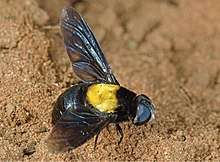Marleyimyia xylocopae
Marleyimyia xylocopae is a species of bee fly from South Africa that has a similarity to the patterning of a carpenter bee Xylocopa flavicollis (De Geer, 1778) found in the region. The species is considered to be distinctive and only one of three within the genus Marleyimyia. The other members of the genus are Marleyimyia goliath described from Peninsular Malaysia and M. natalensis from southern Africa. Members in the genus have been presumed to be crepuscular or nocturnal but this species was found to be diurnal.[1]
| Marleyimyia xylocopae | |
|---|---|
 | |
| Female holotype, photographed in Ndumo Game Preserve, South Africa on 1 December 2014 | |
| Scientific classification | |
| Kingdom: | Animalia |
| Phylum: | Arthropoda |
| Class: | Insecta |
| Order: | Diptera |
| Family: | Bombyliidae |
| Genus: | Marleyimyia |
| Species: | M. xylocopae |
| Binomial name | |
| Marleyimyia xylocopae Marshall & Evenhuis, 2015 | |
Controversy about photography-based taxonomy
The species was unusual in being described on the basis of two photographs, without the collection, designation of a holotype specimen and deposition in a suitable repository. This method provoked in 2016 a controversy among taxonomists, with a paper arguing for photography-based taxonomy by Pape [2] (with 34 signatories), quickly followed by papers arguing against it by Krell [3] (with 5 signatories) and Ceríaco et al.[4] (with 496 authors).
See also
- Eulophophyllum kirki Ingrisch & Riede, 2016 — a katydid described only from photographs.
References
- Marshall SA; Evenhuis NL (2015). "New species without dead bodies: a case for photo-based descriptions, illustrated by a striking new species of Marleyimyia Hesse (Diptera, Bombyliidae) from South Africa". ZooKeys (525): 117–127. doi:10.3897/zookeys.525.6143. PMC 4607853. PMID 26487819.

- Pape, Thomas (2016). "Taxonomy: Species can be named from photos". Nature. 537 (7620): 307. doi:10.1038/537307b. ISSN 0028-0836. PMID 27629630.

- Krell, Frank T. (2016). "Taxonomy: Preserve specimens for reproducibility". Nature. 539 (7628): 168. doi:10.1038/539168b. ISSN 0028-0836. PMID 27830800.

- Ceríaco, Luis M. P.; Gutiérrez, Eliécer E.; Dubois, Alain; et al. (2016). "Photography-based taxonomy is inadequate, unnecessary, and potentially harmful for biological sciences". Zootaxa. 4196 (3): 435. doi:10.11646/zootaxa.4196.3.9. ISSN 1175-5334. PMID 27988669.
